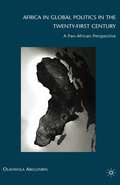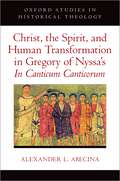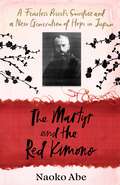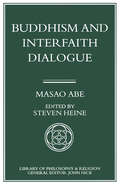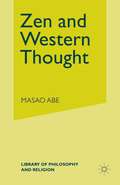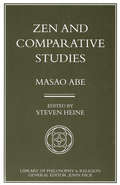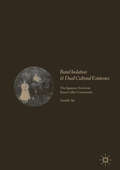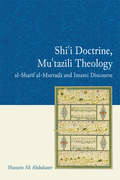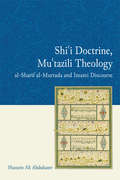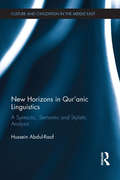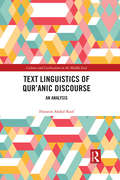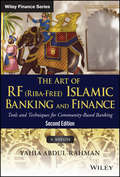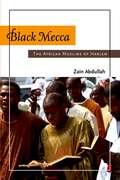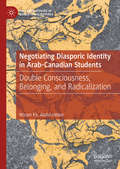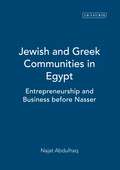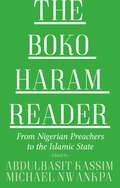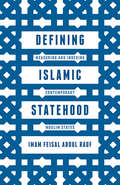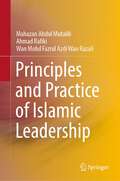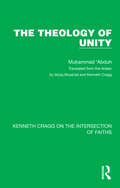- Table View
- List View
Africa in Global Politics in the Twenty-First Century: A Pan-African Perspective
by Olayiwola AbegunrinIn the twenty-first century, Africa has become an important source of US energy imports and the world's natural resources. It has also become the epicentre of the world's deadly health epidemic, HIV/AIDS, and one of the battlegrounds in the fight against terrorism. Africa is now a major player in global affairs.
Christ, the Spirit, and Human Transformation in Gregory of Nyssa's In Canticum Canticorum (Oxford Studies in Historical Theology)
by Alexander L. AbecinaThis book provides a comprehensive literary and theological analysis of Gregory of Nyssa's theology of union with God, culminating in a fresh reading of his final written work, In Canticum Canticorum (c.391), a collection of fifteen allegorical homilies on the Song of Songs. Part I gives the essential background for the study of In Canticum Canticorum by analysing several of Gregory's earlier works (c.370--385), tracing the main contours of his account of the human transformation and union with God. Author Alexander Abecina explores topics such as Gregory's theology of virginity and spiritual marriage, his theology of baptism, his trinitarian theology, and his Spirit-based Christology. In Part II Abecina builds on his key findings in Part I to structure a detailed analysis of In Canticum Canticorum. Engaging with the latest contemporary scholarship on Gregory of Nyssa, the author shows how Gregory's allegorical interpretation of the Song of Songs represents a corresponding account of human transformation and union with God from the perspective of subjective experience of this reality. Rather than marking a new development in Gregory's mature thought, Abecina demonstrates that the subjective experience gained from Gregory's reading of the Song of Songs recapitulates the key elements of his objective account and therefore renders coherent his earlier soteriological doctrine.
Christ, the Spirit, and Human Transformation in Gregory of Nyssa's In Canticum Canticorum (Oxford Studies in Historical Theology)
by Alexander L. AbecinaThis book provides a comprehensive literary and theological analysis of Gregory of Nyssa's theology of union with God, culminating in a fresh reading of his final written work, In Canticum Canticorum (c.391), a collection of fifteen allegorical homilies on the Song of Songs. Part I gives the essential background for the study of In Canticum Canticorum by analysing several of Gregory's earlier works (c.370--385), tracing the main contours of his account of the human transformation and union with God. Author Alexander Abecina explores topics such as Gregory's theology of virginity and spiritual marriage, his theology of baptism, his trinitarian theology, and his Spirit-based Christology. In Part II Abecina builds on his key findings in Part I to structure a detailed analysis of In Canticum Canticorum. Engaging with the latest contemporary scholarship on Gregory of Nyssa, the author shows how Gregory's allegorical interpretation of the Song of Songs represents a corresponding account of human transformation and union with God from the perspective of subjective experience of this reality. Rather than marking a new development in Gregory's mature thought, Abecina demonstrates that the subjective experience gained from Gregory's reading of the Song of Songs recapitulates the key elements of his objective account and therefore renders coherent his earlier soteriological doctrine.
The Martyr and the Red Kimono: A Fearless Priest’s Sacrifice and A New Generation of Hope in Japan
by Naoko AbeThe remarkable true story of Saint Maximilian Kolbe, and the two men in war-torn Japan whose lives he changed forever.On the 14th of August 1941, a Polish priest named Maximilian Maria Kolbe was murdered in Auschwitz.Kolbe's life had been remarkable. Fiercely intelligent and driven, he founded a movement of Catholicism and spent several years in Nagasaki, ministering to the 'hidden Christians' who had emerged after centuries of oppression. A Polish nationalist as well as a priest, he gave sanctuary to fleeing refugees and ran Poland's largest publishing operation, drawing the wrath of the Nazis. His death was no less remarkable: he volunteered to die, saving the life of a fellow prisoner.It was an act that profoundly transformed the lives of two Japanese men. Tomei Ozaki was just seventeen when the US dropped an atomic bomb on Nagasaki, destroying his home and his family. Masatoshi Asari worked on a farm in Hokkaido during the war and was haunted by the inhumane treatment of prisoners in a nearby camp. Forged in the crucible of an unforgiving war, both men drew inspiration from Kolbe's sacrifice, dedicating their lives to humanity and justice. Ozaki followed in his footsteps and became a friar. Asari created cherry trees as peace offerings.In The Martyr and the Red Kimono, award-winning author Naoko Abe weaves together a deeply moving and inspirational true story of resistance, sacrifice, guilt and atonement.
Buddhism and Interfaith Dialogue: Part one of a two-volume sequel to Zen and Western Thought (Library of Philosophy and Religion)
by Masao AbeThis book tries to clarify a Buddhist view of interfaith dialogue from various points of view. It discusses how the Buddhist notion of Sunyata (Emptiness) works dynamically for mutual understanding and transformation of world religions. It also analyzes dialogue between Buddhism and Contemporary Christian theology, especially that of Paul Tillioh and Langdon Gillay.
Zen and Western Thought: A Third Sequel To Zen And Western Thought (Library of Philosophy and Religion)
by Masao AbeZen and Comparative Studies (Library of Philosophy and Religion)
by M. AbeZen is not a religion of God. Nor a religion of faith. It is a religion of emptiness, a religion of absolute nothingness. However it is not nihilistic but dynamically positive. For Zen is based on self-awakening, awakening to the self. In this book, a sequel to Zen and Western Thought, the author tries to clarify the true meaning of Buddhist emptiness in comparison with Aristotelian notion of substance and Whiteheadron notion of process. He also emphasises that Buddhism completely defies and overcomes dualism, but it is not monistic, but rather nondualistic. What is Nondualism? This is one of the important themes of this book.
Rural Isolation and Dual Cultural Existence: The Japanese-American Kona Coffee Community
by David K. AbeThis book studies the Japanese-American coffee farmers in Kona, Hawaii. Specifically, it sheds light on the role of first and second generation immigrants in the emergence of the Kona coffee agricultural economy, as well as factors that contributed to the creation of the Japanese community in Kona. The people there have survived much turmoil, including harsh treatment on the sugar plantations, economic instability, Pearl Harbor and racial stigma, and ethnic and religious identity crises. Despite these challenges, the pillars of the Japanese coffee community have remained stable.
Rural Isolation and Dual Cultural Existence: The Japanese-American Kona Coffee Community
by David K. AbeThis book studies the Japanese-American coffee farmers in Kona, Hawaii. Specifically, it sheds light on the role of first and second generation immigrants in the emergence of the Kona coffee agricultural economy, as well as factors that contributed to the creation of the Japanese community in Kona. The people there have survived much turmoil, including harsh treatment on the sugar plantations, economic instability, Pearl Harbor and racial stigma, and ethnic and religious identity crises. Despite these challenges, the pillars of the Japanese coffee community have remained stable.
Shi'i Doctrine, Mu'tazili Theology: al-Sharif al-Murtada and Imami Discourse
by Hussein Ali AbdulsaterExamines the critical turn that shaped Imami Shi'ism in the 10th and 11th centuries God is not free to act; He is bound by human ethics. To be just, He must create an individual of perfect intellect and infallible morality. People are obligated to submit to this person; otherwise eternal damnation awaits them.While these claims may be interpreted as an affront to God’s power, an insult to human judgment and a justification for despotism, ShiÊ¿i Muslims in the eleventh century eagerly adopted them in their attempts to forge a ‘rational’ religious discourse. They utilized everything from literary studies and political theory to natural philosophy and metaphysical speculation in support of this project. This book presents the contribution of al-SharÄ«f al-Murtaá¸ Ä (d. 1044) of Baghdad, the thinker most responsible for this irreversible change, which remains central to Imami identity. It analyzes his intellectual project and establishes the dynamic context which prompted him to pour the old wine of ShiÊ¿i doctrine into the new wineskin of systematic MuÊ¿tazili theology. Key FeaturesComprehensive coverage of al-Murtaá¸ Ä â€™s enormous oeuvre (running to several thousand pages) and diversity (spanning virtually all contemporary fields of knowledge)A meticulous engagement with long and dense theoretical texts that are either in manuscript form or poorly editedAn orderly presentation that equips readers with an overall understanding of ShiÊ¿i theology in its main phases while preserving the profundity of analysisThe study of a little-known author whose views, nonetheless, are still a major influence for ShiÊ¿i Muslims
Shi'i Doctrine, Mu'tazili Theology: al-Sharif al-Murtada and Imami Discourse
by Hussein Ali AbdulsaterExamines the critical turn that shaped Imami Shi'ism in the 10th and 11th centuries God is not free to act; He is bound by human ethics. To be just, He must create an individual of perfect intellect and infallible morality. People are obligated to submit to this person; otherwise eternal damnation awaits them.While these claims may be interpreted as an affront to God’s power, an insult to human judgment and a justification for despotism, ShiÊ¿i Muslims in the eleventh century eagerly adopted them in their attempts to forge a ‘rational’ religious discourse. They utilized everything from literary studies and political theory to natural philosophy and metaphysical speculation in support of this project. This book presents the contribution of al-SharÄ«f al-Murtaá¸ Ä (d. 1044) of Baghdad, the thinker most responsible for this irreversible change, which remains central to Imami identity. It analyzes his intellectual project and establishes the dynamic context which prompted him to pour the old wine of ShiÊ¿i doctrine into the new wineskin of systematic MuÊ¿tazili theology. Key FeaturesComprehensive coverage of al-Murtaá¸ Ä â€™s enormous oeuvre (running to several thousand pages) and diversity (spanning virtually all contemporary fields of knowledge)A meticulous engagement with long and dense theoretical texts that are either in manuscript form or poorly editedAn orderly presentation that equips readers with an overall understanding of ShiÊ¿i theology in its main phases while preserving the profundity of analysisThe study of a little-known author whose views, nonetheless, are still a major influence for ShiÊ¿i Muslims
New Horizons in Qur'anic Linguistics: A Syntactic, Semantic and Stylistic Analysis (Culture and Civilization in the Middle East)
by Hussein Abdul-RaofNew Horizons in Qur'anic Linguistics provides a panoramic insight into the Qur'anic landscape fenced by innate syntactic, semantic and stylistic landmarks where context and meaning have closed ranks to impact morphological form in order to achieve variegated illocutionary forces. It provides a comprehensive account of the recurrent syntactic, stylistic, morphological, lexical, cultural, and phonological voids that are an iceberg looming in the horizon of Qur'anic genre. It is an invaluable resource for contrastive linguistics, translation studies, and corpus linguistics. Among the linguistic topics are: syntactic structures, ellipsis, synonymy, polysemy, semantic redundancy, incongruity, and contrastiveness, selection restriction rule, componential features, collocation, cyclical modification, foregrounding, backgrounding, pragmatic functions and categories of shift, pragmatic distinction between verbal and nominal sentences, morpho-semantic features of lexical items, context-sensitive word and phrase order, vowel points and phonetic variation. The value of European theoretical linguistics to the analysis of the Qur’anic text at a macro level has been overlooked in the academic literature to date and this book addresses this research gap, providing a key resource for students and scholars of linguistics and specifically working in Arabic or Qur’anic Studies.
New Horizons in Qur'anic Linguistics: A Syntactic, Semantic and Stylistic Analysis (Culture and Civilization in the Middle East)
by Hussein Abdul-RaofNew Horizons in Qur'anic Linguistics provides a panoramic insight into the Qur'anic landscape fenced by innate syntactic, semantic and stylistic landmarks where context and meaning have closed ranks to impact morphological form in order to achieve variegated illocutionary forces. It provides a comprehensive account of the recurrent syntactic, stylistic, morphological, lexical, cultural, and phonological voids that are an iceberg looming in the horizon of Qur'anic genre. It is an invaluable resource for contrastive linguistics, translation studies, and corpus linguistics. Among the linguistic topics are: syntactic structures, ellipsis, synonymy, polysemy, semantic redundancy, incongruity, and contrastiveness, selection restriction rule, componential features, collocation, cyclical modification, foregrounding, backgrounding, pragmatic functions and categories of shift, pragmatic distinction between verbal and nominal sentences, morpho-semantic features of lexical items, context-sensitive word and phrase order, vowel points and phonetic variation. The value of European theoretical linguistics to the analysis of the Qur’anic text at a macro level has been overlooked in the academic literature to date and this book addresses this research gap, providing a key resource for students and scholars of linguistics and specifically working in Arabic or Qur’anic Studies.
Text Linguistics of Qur'anic Discourse: An Analysis (Culture and Civilization in the Middle East)
by Hussein Abdul-RaofText Linguistics of Qur'anic Discourse is an in-depth investigation of the fabric of Qur'anic Discourse. It unravels the texture of the macro Qur'anic text; its cohesion and coherence systems; the notions of intertextuality, semantic relatedness, and thematic sequentiality; the macro textual features of ellipsis, repetition, and argumentation structure; and the contextual, co-textual, grammatical, and semantic factors involved in the macro Qur'anic text. This book is a valuable and methodologically consistent learning and teaching academic resource for universities worldwide in this intriguing new discipline. Through its methodologically coherent discussion and in-depth analysis that is hinged upon modern European text linguistics, Text Linguistics of Qur'anic Discourse provides an insight into the newly established discipline of text linguistics, and explores the different layers of the macro Qur'anic text as an academic requirement.
Text Linguistics of Qur'anic Discourse: An Analysis (Culture and Civilization in the Middle East)
by Hussein Abdul-RaofText Linguistics of Qur'anic Discourse is an in-depth investigation of the fabric of Qur'anic Discourse. It unravels the texture of the macro Qur'anic text; its cohesion and coherence systems; the notions of intertextuality, semantic relatedness, and thematic sequentiality; the macro textual features of ellipsis, repetition, and argumentation structure; and the contextual, co-textual, grammatical, and semantic factors involved in the macro Qur'anic text. This book is a valuable and methodologically consistent learning and teaching academic resource for universities worldwide in this intriguing new discipline. Through its methodologically coherent discussion and in-depth analysis that is hinged upon modern European text linguistics, Text Linguistics of Qur'anic Discourse provides an insight into the newly established discipline of text linguistics, and explores the different layers of the macro Qur'anic text as an academic requirement.
The Art of RF: Tools and Techniques for Community-Based Banking (Wiley Finance)
by Yahia Abdul-RahmanUpdated and expanded insights into Islamic banking and finance From Yahia Abdul-Rahman-the father of Riba-Free (RF) banking-comes the expanded edition of the definitive resource that offers an understanding for applying Islamic banking and financial practices. No matter what your faith or religious beliefs, the book shows how to take a modern American approach to incorporating Islamic financial principles into banking and investment techniques. The Art of RF (Riba-Free) Islamic Banking and Finance describes the emergence of a culture of Islamic banking and finance today, which is based on the real Judeo-Christian-Islamic spirit and has proven very effective when compared to 20th century models that use financial engineering and structural techniques to circumvent the Shari'aa Law. The author also reveals information about how fiat money is created, the role of the Federal Reserve, and the US banking system. Abdul-Rahman includes a wealth of real-life examples and offers an analysis of how this new brand of banking and financing yields superior results. Offers the fundamentals on Riba-Free (RF) banking Shows how to apply RF to everything from joint ventures and portfolio management to home mortgages and personal finance Reveals what it takes to incorporate Shariah Law into US financial systems Includes information on why RF banking is a socially responsible way to invest Thoroughly revised and updated, this resource offers a handbook for applying Shari'aa law to American banking and finance.
The Art of RF: Tools and Techniques for Community-Based Banking (Wiley Finance)
by Yahia Abdul-RahmanUpdated and expanded insights into Islamic banking and finance From Yahia Abdul-Rahman-the father of Riba-Free (RF) banking-comes the expanded edition of the definitive resource that offers an understanding for applying Islamic banking and financial practices. No matter what your faith or religious beliefs, the book shows how to take a modern American approach to incorporating Islamic financial principles into banking and investment techniques. The Art of RF (Riba-Free) Islamic Banking and Finance describes the emergence of a culture of Islamic banking and finance today, which is based on the real Judeo-Christian-Islamic spirit and has proven very effective when compared to 20th century models that use financial engineering and structural techniques to circumvent the Shari'aa Law. The author also reveals information about how fiat money is created, the role of the Federal Reserve, and the US banking system. Abdul-Rahman includes a wealth of real-life examples and offers an analysis of how this new brand of banking and financing yields superior results. Offers the fundamentals on Riba-Free (RF) banking Shows how to apply RF to everything from joint ventures and portfolio management to home mortgages and personal finance Reveals what it takes to incorporate Shariah Law into US financial systems Includes information on why RF banking is a socially responsible way to invest Thoroughly revised and updated, this resource offers a handbook for applying Shari'aa law to American banking and finance.
Black Mecca: The African Muslims of Harlem
by Zain AbdullahThe changes to U.S. immigration law that were instituted in 1965 have led to an influx of West African immigrants to New York, creating an enclave Harlem residents now call ''Little Africa.'' These immigrants are immediately recognizable as African in their wide-sleeved robes and tasseled hats, but most native-born members of the community are unaware of the crucial role Islam plays in immigrants' lives. Zain Abdullah takes us inside the lives of these new immigrants and shows how they deal with being a double minority in a country where both blacks and Muslims are stigmatized. Dealing with this dual identity, Abdullah discovers, is extraordinarily complex. Some longtime residents embrace these immigrants and see their arrival as an opportunity to reclaim their African heritage, while others see the immigrants as scornful invaders. In turn, African immigrants often take a particularly harsh view of their new neighbors, buying into the worst stereotypes about American-born blacks being lazy and incorrigible. And while there has long been a large Muslim presence in Harlem, and residents often see Islam as a force for social good, African-born Muslims see their Islamic identity disregarded by most of their neighbors. Abdullah weaves together the stories of these African Muslims to paint a fascinating portrait of a community's efforts to carve out space for itself in a new country.
Black Mecca: The African Muslims of Harlem
by Zain AbdullahThe changes to U.S. immigration law that were instituted in 1965 have led to an influx of West African immigrants to New York, creating an enclave Harlem residents now call ''Little Africa.'' These immigrants are immediately recognizable as African in their wide-sleeved robes and tasseled hats, but most native-born members of the community are unaware of the crucial role Islam plays in immigrants' lives. Zain Abdullah takes us inside the lives of these new immigrants and shows how they deal with being a double minority in a country where both blacks and Muslims are stigmatized. Dealing with this dual identity, Abdullah discovers, is extraordinarily complex. Some longtime residents embrace these immigrants and see their arrival as an opportunity to reclaim their African heritage, while others see the immigrants as scornful invaders. In turn, African immigrants often take a particularly harsh view of their new neighbors, buying into the worst stereotypes about American-born blacks being lazy and incorrigible. And while there has long been a large Muslim presence in Harlem, and residents often see Islam as a force for social good, African-born Muslims see their Islamic identity disregarded by most of their neighbors. Abdullah weaves together the stories of these African Muslims to paint a fascinating portrait of a community's efforts to carve out space for itself in a new country.
Negotiating Diasporic Identity in Arab-Canadian Students: Double Consciousness, Belonging, and Radicalization (Palgrave Studies in Educational Futures)
by Wisam Kh. Abdul-JabbarThis book, framed through the notion of double consciousness, brings postcolonial constructs to sociopolitical and pedagogical studies of youth that have yet to find serious traction in education. Significantly, this book contributes to a growing interest among educational and curriculum scholars in engaging the pedagogical role of literature in the theorization of an inclusive curriculum. Therefore, this study not only recognizes the potential of immigrant literature in provoking critical conversation on changes young people undergo in diaspora, but also explores how the curriculum is informed by the diasporic condition itself as demonstrated by this negotiation of foreignness between the student and selected texts.
Jewish and Greek Communities in Egypt: Entrepreneurship and Business before Nasser (Library of Middle East History)
by Najat AbdulhaqIn the years following Nasser's rise to power, the demographic landscape and the economy of Egypt underwent a profound change. Related to the migration of diverse communities, that had a distinguished role in Egyptian economy, from Egypt, these shifts have mostly been discussed in the light of postcolonial studies and the nationalisation policies in the wider region. Najat Abdulhaq focuses instead on the role that these minorities had in the economy of pre-Nasser Egypt and, by giving special attention to the Jewish and Greek communities residing in Egypt, investigates the dynamics of minorities involved in entrepreneurship and business. With rigorous analysis of the types of companies that were set up, Abdulhaq draws out the changes which were occurring in the political and social sphere at the time. This book, whilst primarily focused on the economic activities of these two minority communities, has implications for an understanding analysis of the political, the juridical, the intellectual and the cultural trends at the time. It thus offers vital analysis for those examining the economic history of Egypt, as well as the political and cultural transformations of the twentieth century in the region.
The Boko Haram Reader: From Nigerian Preachers to the Islamic State
by Abdulbasit Kassim and Michael NwankpaSince it erupted onto the world stage in 2009, people have asked, what is Boko Haram, and what does it stand for? Is there a coherent vision or set of beliefs behind it? Despite the growing literature about the group, few if any attempts have been made to answer these questions, even though Boko Haram is but the latest in a long line of millenarian Muslim reform groups to emerge in Northern Nigeria over the last two centuries. The Boko Haram Reader offers an unprecedented collection of essential texts, documents, videos, audio, and nashids (martial hymns), translated into English from Hausa, Arabic and Kanuri, tracing the group's origins, history, and evolution. Its editors, two Nigerian scholars, reveal how Boko Haram's leaders manipulate Islamic theology for the legitimisation, radicalization, indoctrination and dissemination of their ideas across West Africa. Mandatory reading for anyone wishing to grasp the underpinnings of Boko Haram's insurgency, particularly how the group strives to delegitimize its rivals and establish its beliefs as a dominant strand of Islamic thought in West Africa's religious marketplace.
Defining Islamic Statehood: Measuring and Indexing Contemporary Muslim States
by Imam Feisal Abdul RaufThis groundbreaking book offers in-depth analysis of the modern Islamic state, applying a quantitative measurement of how Muslim majority nations meet the definition. Content for the book was developed through extensive debate among a panel of distinguished Sunni and Shia Muslim scholars over seven years.
Principles and Practice of Islamic Leadership
by Mahazan Abdul Mutalib Ahmad Rafiki Wan Mohd Wan RazaliThis book elaborates the fundamental principles and practices of Islamic leadership and management by highlighting its underlying philosophies, key concepts, and sources. The book closely examines the relationship of Islamic leadership with spiritual leadership and how it shapes the concept of leadership. The book also compares Islamic Leadership with other related spiritual leadership concepts such as the Servant Leadership, religiosity, and other conventional leadership perspectives based on Islamic framework. The chapters within the book delve into Islamic teachings and values from Al-Qur’an and Hadith that can be applied when governing an organization using several case studies. This insightful and thorough discussion on Islamic leadership will be useful as a reference for academic courses on leadership, and current and aspiring business leaders.
The Theology of Unity (Kenneth Cragg on the Intersection of Faiths #2)
by Muhammad 'AbduhOriginally published in 1966, this was the first of Muhammad ‘Abduh’s works to be translated into English. Risālat al Tauhid represents the most popular of his discussion of Islamic thought and belief. ‘Abduh is still quoted and revered as the father of 20th Century Muslim thinking in the Arab world and his mind, here accessible, constituted both courageous and strenuous leadership in his day. All the concerns and claims of successive exponents of duty and meaning of the mosque in the modern world may be sensed in these pages. The world and Islam have moved on since ‘Abduh’s lifetime, but he remains a source for the historian of contemporary movements and a valuable index to the self-awareness of Arab Islam.
